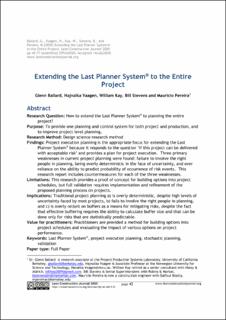| dc.contributor.author | Ballard, Glenn | |
| dc.contributor.author | Vaagen, Hajnalka | |
| dc.contributor.author | Kay, William | |
| dc.contributor.author | Stevens, Bill | |
| dc.contributor.author | Pereira, Mauricio | |
| dc.date.accessioned | 2022-05-04T10:20:06Z | |
| dc.date.available | 2022-05-04T10:20:06Z | |
| dc.date.created | 2020-10-08T07:01:04Z | |
| dc.date.issued | 2020 | |
| dc.identifier.citation | Lean Construction Journal. 2020, 42-77. | en_US |
| dc.identifier.issn | 1555-1369 | |
| dc.identifier.uri | https://hdl.handle.net/11250/2994117 | |
| dc.description.abstract | Research Question: How to extend the Last Planner System® to planning the entire project? Purpose: To provide one planning and control system for both project and production, and to improve project level planning. Research Method: Design science research method Findings: Project execution planning is the appropriate focus for extending the Last Planner System® because it responds to the question ‘If this project can be delivered with acceptable risk’ and provides a plan for project execution. Three primary weaknesses in current project planning were found: failure to involve the right people in planning, being overly deterministic in the face of uncertainty, and over reliance on the ability to predict probability of occurrence of risk events. This research report includes countermeasures for each of the three weaknesses. Limitations: This research provides a proof of concept for building options into project schedules, but full validation requires implementation and refinement of the proposed planning process on projects. Implications: Traditional project planning a) is overly deterministic, despite high levels of uncertainty faced by most projects, b) fails to involve the right people in planning, and c) is overly reliant on buffers as a means for mitigating risks, despite the fact that effective buffering requires the ability to calculate buffer size and that can be done only for risks that are statistically predictable. Value for practitioners: Practitioners are provided a method for building options into project schedules and evaluating the impact of various options on project performance. Keywords: Last Planner System® , project execution planning, stochastic planning, validation Paper type: Full Paper | en_US |
| dc.language.iso | eng | en_US |
| dc.publisher | Lean Construction Institute | en_US |
| dc.rights | Attribution-NonCommercial-NoDerivatives 4.0 Internasjonal | * |
| dc.rights.uri | http://creativecommons.org/licenses/by-nc-nd/4.0/deed.no | * |
| dc.title | Extending the Last Planner System® to the Entire Project | en_US |
| dc.title.alternative | Extending the Last Planner System® to the Entire Project | en_US |
| dc.type | Peer reviewed | en_US |
| dc.type | Journal article | en_US |
| dc.description.version | publishedVersion | en_US |
| dc.source.pagenumber | 42-77 | en_US |
| dc.source.journal | Lean Construction Journal | en_US |
| dc.identifier.cristin | 1838083 | |
| cristin.ispublished | true | |
| cristin.fulltext | original | |
| cristin.qualitycode | 1 | |

